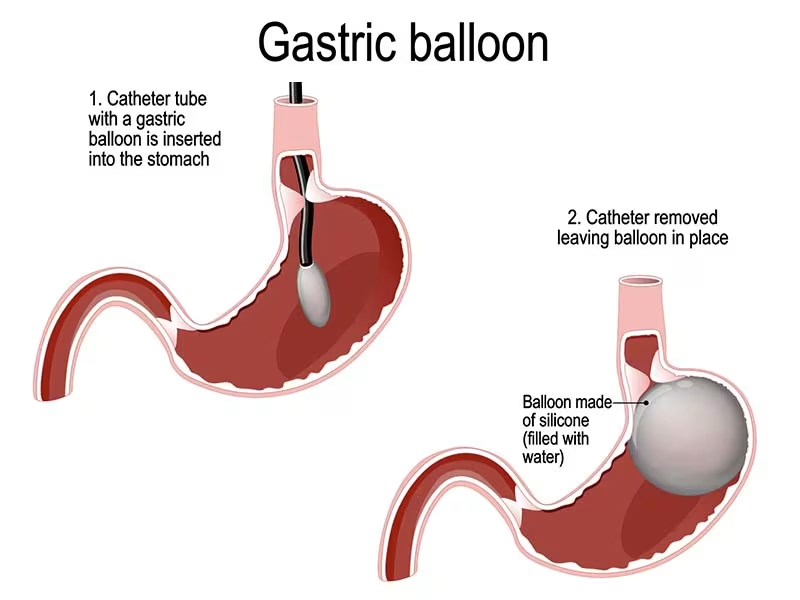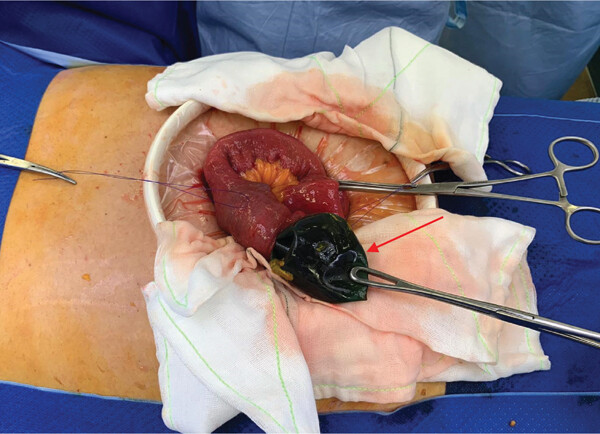Intragastric balloon insertion is a non-surgical weight management option that involves placing a balloon in your stomach through a gastroscopy procedure performed under sedation.
The balloon remains in place for approximately six months before removal, with patients typically experiencing about 15% weight loss from their original weight.
This innovative procedure is primarily designed for individuals with a Body Mass Index (BMI) over 27 who fall below the BMI threshold for obesity surgery.
It’s also suitable for patients who might be too medically compromised to undergo conventional weight loss surgery, offering a safer alternative without leaving scars on the abdominal wall.
How Intragastric Balloons Work

After insertion, the balloon occupies space within your stomach, effectively reducing the stomach cavity by about one-third.
This physical presence suppresses appetite, creating a sensation of fullness that lasts longer after eating smaller amounts of food.
As a result, patients naturally consume less without having to consciously restrict their intake.
For most patients, the intragastric balloon serves as an effective kickstart to their weight loss journey.
During the six-month period with the balloon, patients work with a support team to develop sustainable healthy habits like portion control and regular exercise—behaviors that can be maintained long after the balloon is removed.
Read more: The Ultimate Guide to Losing Weight in Singapore
Types of Gastric Balloons Available in Singapore
There are several types of intragastric balloons available in Singapore, each with distinct features:
Traditional Intragastric Balloons
Traditional intragastric balloons require endoscopy and sedation for placement.
During this process, the doctor inserts a catheter tube with the deflated gastric balloon down into the stomach, followed by an endoscope with a camera to view the balloon while filling it with saline solution.
After approximately 6 months, the balloon is removed through another endoscopic procedure.
You might be interested: Comprehensive Guide to Colonoscopy in Singapore
Elipse Balloon

The innovative Elipse balloon by Allurion Technologies offers a procedure without surgery, endoscopy, or anesthesia.
This ingestible gastric balloon comes in a capsule attached to a catheter, which the patient swallows with water. An X-ray confirms proper placement in the stomach before the balloon is filled via the catheter.
A second X-ray ensures the balloon is properly inflated, after which the catheter is detached, completing the procedure.After approximately 16 weeks, a time-activated release valve opens, allowing the balloon to empty and pass naturally through the digestive system.
The Elipse gastric balloon is particularly popular among patients as it’s the only option that doesn’t require endoscopy for insertion or removal, making it as simple to administer as taking a regular pill.
You might like: Non-Surgical Fat Reduction: Treatments, Benefits, and Risks
Recovery and Diet After Intragastric Balloon Insertion
The first three days after insertion require a liquid diet to help your body adjust to the balloon’s presence. From day 4 to day 14, patients gradually incorporate soft foods such as porridge and pureed foods into their diet.
By the 14th day, most patients can resume a normal, healthy diet that’s low in sugar, fat, and carbohydrates.
A typical dietary progression after balloon insertion looks like:
Days 1-3 (Liquid Diet):
- Skimmed milk
- Herbal teas
- Diluted low-sugar fruit juices
- Clear beef or chicken broth
Days 4-7 (Soft Foods):
- Yogurt
- Porridge
- Thicker soups like cream of mushroom
- Mashed potatoes
- Blended foods (fish, lean meats, fibrous fruits and vegetables)
This might help: Homeopathy in Singapore
From Day 10 onwards:
- Normal but healthy foods with some restrictions
Foods to avoid:
- Tough and fibrous food
- Soft, doughy bread
- Overcooked rice and pasta
- Hard vegetables and fruits
- Lettuce
- Skins and small seeds
- Foods rich in fat (pies, pastry, cheese, cream)
- Coffee and alcohol
- Strongly flavored foods like curries
Related article: Health Screening in Singapore
Eligibility for Intragastric Balloon Procedure
The intragastric balloon has become a popular option for individuals who have attempted weight loss through diet and exercise without sustainable success.
It’s also frequently chosen by those with serious health conditions related to obesity who seek a less invasive intervention.
You may be a suitable candidate if:
- You’ve tried other weight loss methods without success
- Your BMI is between 27 and 40 (lower than what’s required for bariatric surgery)
- You have one or more weight-related health issues such as type 2 diabetes, high blood pressure, fatty liver disease, or sleep apnea
This might help: Best JB Health Screening Clinics for Singaporeans
You may not be suitable if you:
- Have had previous bariatric or gastrointestinal surgery
- Have an inflammatory disease of the gastrointestinal tract
- Have conditions such as gastric mass, hiatal hernia, or liver failure
- Have difficulty swallowing
- Have structural abnormality of the esophagus or larynx
- Are not willing to adopt dietary habits and behavioral changes
- Are experiencing drug or alcohol addiction
- Have serious or uncontrolled psychiatric illness
- Are pregnant or breastfeeding
- Are under 18 years old
- Have immune system compromise
Risks and Complications

Most patients who undergo the intragastric balloon procedure do not experience significant complications. However, abdominal discomfort, nausea, and vomiting are common during the first three days following insertion.
A small subset of patients may be unable to tolerate the side effects of the balloon and require removal.
For these individuals, healthcare providers typically attempt medication and hydration to manage symptoms, with surgical removal being considered only when all other approaches fail.
Safety and Efficacy of the Elipse Balloon
A comprehensive study involving 1,770 Elipse patients demonstrated that the balloon could be easily swallowed, with only one patient unable to complete this step. Approximately 35.9% of patients required some assistance during swallowing.
The Elipse balloon showed good tolerability overall. Side effects like nausea and vomiting were effectively controlled with medication.
The percentage of patients who experienced intolerance requiring balloon removal was relatively low at 2.9%. In terms of exit, 95.6% of balloons safely passed through the gastrointestinal tract naturally. Eleven empty balloons were vomited at the endpoint without adverse events.
While three cases of small bowel obstruction were reported and managed with laparoscopy, these adverse events were rare and occurred with earlier generations of the Elipse balloon.
After design modifications, no small bowel obstructions were reported in 635 patients treated after 2018.
Similarly, the issue of spontaneous hyperinflation that required endoscopic removal in 4 patients was addressed with a manufacturing change to the filling liquid, with no further incidents reported thereafter.
In terms of effectiveness, Elipse balloons demonstrated remarkable results with 14.2 percent total body weight loss (TBWL) and improvements across all metabolic parameters.
This might help: Acid Reflux and GERD in Singapore: Causes, Symptoms, and Treatments
Benefits of Intragastric Balloon Compared to Surgery
The intragastric balloon offers several advantages over surgical weight loss options:
- No surgery required
- No endoscopy needed (for Elipse balloons, except in rare complication cases)
- No anesthesia (for Elipse balloons)
- Shorter discharge time
- Faster recovery
- Effective weight loss outcomes
- No scars or incisions
- No permanent changes to the digestive system
- Lower risk of complications
Expected Weight Loss and Long-Term Results
Patients can typically expect to lose between 10% to 15% of their total body weight with an intragastric balloon. The actual amount lost depends on starting weight and the individual’s ability to implement and maintain a new diet and exercise regimen.
It’s crucial to continue the new dietary and exercise habits even after the gastric balloon is removed, as weight regain is possible without sustained lifestyle changes.
For this reason, having a multi-disciplinary team supporting the weight loss journey is important.
While the intragastric balloon itself is temporary, it serves as a tool to help reprogram eating habits. Studies show patients achieve an average weight loss of around half of their excess weight.
Predictors of Balloon Intolerance
Research has identified certain factors that may predict balloon intolerance leading to early removal.
A retrospective cohort study of 54 consecutive patients who underwent IGB insertion found that 47 patients (87.0%) completed therapy, while 7 patients (13.0%) required early removal due to intolerance.
Multivariate analysis revealed significant associations between early balloon removal and both depression and anxiety.
Further univariate analysis showed that anxiety was the main risk factor, with depression no longer being a significant predictor when analyzed independently.
This suggests the importance of identifying predictors of balloon intolerance to enhance patient selection and improve peri-procedural care.
For patients with a history of depression or anxiety, adequate counseling and preparation prior to balloon insertion may be particularly beneficial.
Cost of Intragastric Balloon in Singapore
The cost of an Elipse balloon in Singapore is typically several thousand dollars, varying depending on the clinic.
Medical experts recommend choosing a clinic that offers both gastric balloon and bariatric surgery options to ensure unbiased recommendations based on individual needs rather than limited service offerings.
Comprehensive FAQ About Intragastric Balloons
What is an intragastric balloon?
An intragastric balloon is a soft, expandable silicone device inserted into the stomach either through swallowing (in the case of the Elipse balloon) or via endoscopy.
Once in place, the balloon is filled with saline solution, sometimes containing methylene blue dye, which helps it occupy space in the stomach.
This reduces the effective capacity of the stomach, leading to earlier feelings of fullness and reduced food intake, ultimately promoting weight loss.
How is the intragastric balloon inserted?
There are two main insertion methods depending on the type of balloon:
For traditional balloons, the procedure is performed under sedation and requires endoscopy. A deflated balloon attached to a catheter is inserted through the mouth and esophagus into the stomach.
Using an endoscope with a camera, the doctor guides and fills the balloon with saline solution before detaching it from the catheter.
For the newer Elipse balloon, no sedation or endoscopy is needed. The patient swallows a capsule containing the deflated balloon, which is attached to a thin catheter.
X-rays confirm proper placement, after which the balloon is filled through the catheter. Once filled, the catheter is disconnected, and the procedure is complete.
How much weight can I lose with an intragastric balloon?
Most patients can expect to lose between 10% and 15% of their total body weight with an intragastric balloon. For example, a person weighing 100 kg might lose 10-15 kg over the treatment period. However, results vary based on individual factors including starting weight, adherence to dietary recommendations, and physical activity levels. Studies show that the Elipse balloon specifically has demonstrated average total body weight loss of 14.2%.
How long does the balloon stay in your stomach?
The duration varies by balloon type. Traditional intragastric balloons typically remain in place for six months before requiring endoscopic removal.
The Elipse balloon is designed to stay in the stomach for approximately 16 weeks (about 4 months), after which a time-activated release valve opens, allowing the balloon to empty and pass naturally through the digestive system without requiring a removal procedure.
Is the procedure painful?
The insertion procedure itself is not painful as it’s either performed under sedation (for traditional balloons) or simply involves swallowing a capsule (for the Elipse balloon).
However, most patients experience some discomfort during the first few days after insertion, including nausea, vomiting, and abdominal cramps. These symptoms typically subside within 3-4 days as the body adjusts to the balloon’s presence.
Medications are provided to manage these symptoms during the adjustment period.
Will I gain the weight back after the balloon is removed?
Weight regain is possible after balloon removal if patients don’t maintain the healthy eating habits and lifestyle changes established during treatment.
The balloon serves primarily as a tool to help develop portion control and healthier eating habits. Patients who continue with proper diet and regular exercise after removal typically maintain better long-term results.
Working with a multidisciplinary team including nutritionists and following post-removal guidance is crucial for sustainable weight management.
How does the intragastric balloon compare to bariatric surgery?
The intragastric balloon is a less invasive, temporary intervention compared to bariatric surgery. Key differences include:
- Balloon: Non-surgical, reversible, shorter recovery time, no permanent anatomical changes, suitable for BMI 27-40, typically results in 10-15% total body weight loss.
- Bariatric surgery: Surgical procedure, permanent/long-lasting anatomical changes, longer recovery period, typically for BMI over 37 or 35 with comorbidities, generally results in greater weight loss (25-35% or more).
The balloon is often chosen by patients not ready for surgery or with lower BMI ranges, while surgery may be more appropriate for those with severe obesity requiring significant, long-term weight reduction.
What are the potential side effects and complications?
Common side effects in the first few days include:
- Nausea (feeling of seasickness)
- Vomiting
- Stomach cramps or discomfort
- Feeling of heaviness in the abdomen
Rare but possible complications include:
- Balloon intolerance requiring early removal
- Balloon rupture (signaled by blue/green urine if methylene blue dye was used in filling)
- Balloon migration
- Small bowel obstruction (extremely rare with newer balloon designs)
The intragastric balloon is considered the safest weight management procedure with the lowest complication rate compared to surgical alternatives.
Who should not get an intragastric balloon?
Several conditions may make you unsuitable for an intragastric balloon:
- Previous stomach or gastrointestinal surgery
- Inflammatory bowel disease
- Hiatal hernia, gastric mass, or liver failure
- Swallowing difficulties
- Pregnancy or plans to become pregnant
- Active drug or alcohol addiction
- Severe psychiatric illness
- Age under 18
- Compromised immune system
A thorough medical evaluation is necessary to determine if you’re an appropriate candidate.
What happens if I can’t tolerate the balloon?
If you experience severe or persistent intolerance symptoms, your healthcare provider will first try medication and hydration to help manage symptoms.
If these measures aren’t effective, early removal of the balloon may be necessary. For traditional balloons, this requires an endoscopic procedure.
The Elipse balloon, if needed, can also be removed endoscopically in cases of severe intolerance, though this is rare, occurring in only about 2.9% of patients.
How is the balloon removed?
Removal depends on the balloon type:
For traditional balloons, removal requires another endoscopic procedure under sedation or anesthesia. The doctor inserts an endoscope with specialized tools to puncture the balloon, drain the fluid, grasp the deflated balloon, and remove it through the mouth.
The Elipse balloon is designed to self-empty after approximately 16 weeks through a time-activated release valve. Once empty, it naturally passes through the digestive system without requiring any procedure. In rare cases of complications, it can be removed endoscopically.
Conclusion
The intragastric balloon presents a viable, non-surgical option for individuals struggling with weight management who haven’t found success with diet and exercise alone.
With multiple balloon types available in Singapore, including the innovative Elipse balloon that eliminates the need for endoscopy, this intervention offers flexibility based on patient preferences and medical needs.
While not a permanent solution, the balloon serves as an effective tool to initiate weight loss and establish healthier eating patterns.
When combined with proper dietary changes, exercise, and behavioral modifications under the guidance of a multidisciplinary team, patients can achieve significant weight reduction and improvements in obesity-related health conditions.
For those considering weight management options in Singapore, consulting with a specialist clinic that offers both balloon and surgical alternatives ensures you receive unbiased recommendations tailored to your specific circumstances, maximizing your chances of long-term weight loss success.

